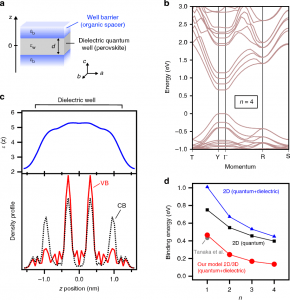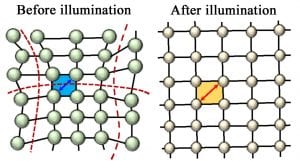Even though, the interest of using organic-inorganic hybrid perovskites as active materials in optoelectronic devices have motivated immense research over the past few years, but the photophysical properties of these materials still need to be explored. However, understanding the fundamental properties of perovskites, in particular the optical properties and the kinetics of carriers – will be beneficial for improving the photovoltaic devices reaching the Shockley-Queisser limit.
Recently, our group has tried to elucidate the light-induced effects on the hybrid perovskite–based optoelectronic device in its working condition. We observed a uniform lattice expansion of the hybrid perovskite thin films under continuous illumination of light, which was observed to be critical for high performance photovoltaic devices. An extensive in-situ structural and device characterizations revealed that the light-induced lattice expansion improved the performance of a mixed-cation (FA0.7MA0.25Cs0.05PbI2) pure-halide planar device from 18.5 to 20.5% (see Tsai et al. Science 360 (6384), 67-70, 2018)
Also recently, we discovered the concept of “layer-edge states” in 2D perovskite thin films (>1.3 nm) which happens to be key for high performance solar cells (close to 13%) and highly flourescent (a few tens of percent) LEDs. The spontaneous conversion of excitons to free carriers through these layer-edge states enables an improvement in the photovoltaic and light-emitting thin-film layered materials as illustrated below. Through an extensive photophysical and opto-electronic characterization, it was revealed that the 2D perovskite thin films have an intrinsic mechanism for the dissociation of strongly bound excitons to long-lived free-carriers provided by lower energy states at the edges of the layered perovskites (see Blancon et al. Science, 2017).
Lately, we proposed a general scaling law for determining the binding energy of excitons in perovskite quantum wells for any layer thickness. We utilized the optical spectroscopy and 60-Tesla magneto-absorption supported by modeling to demonstrate that the optical resonances are arising from the tightly bound excitons; with both exciton reduced masses and binding energies decreasing, with increasing thickness from n equals 1 to 5 in 2D Ruddlesden–Popper halide perovskites (see Blancon et al. Nature communications 9 (1), 2254, 2018).

